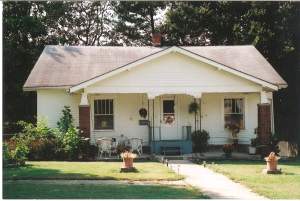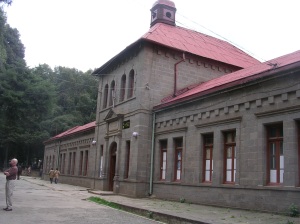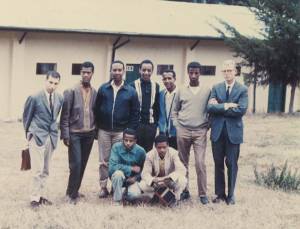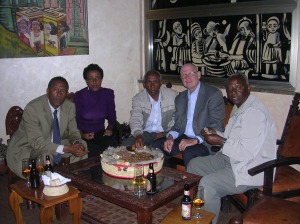A LIFE CHANGING ENCOUNTER


Over the past couple of months, writing about my Peace Corps teaching days at Tafari Makonnen School in Addis Ababa in the 1960s and about my Ethiopian friend Tesfagiorgis’ dark days under the brutal military regime that succeeded Haile Selassie has got me thinking about how I’d made it to Addis in the first place in 1964. It was a true life changer for me, but, as is probably often the case with dramatic course shifts in life, it was hardly the result of a methodical planning process. Indeed, on reflection, it was probably a classic case of serendipity at work. Here’s the first part of my back story.
Early afternoon, December 1963. Walking through the Illini Union at the University of Illinois in Champaign-Urbana, half-way through my senior year, I pass a table where a couple of Peace Corps recruiters are chatting with a cluster of students. Heading out the door, on my way back to my place to do some reading for tomorrow’s Russian history class, I stop and think a minute, then turn around and walk back to the table. When one of the recruiters is free, I ask if the Peace Corps has any use for a guy like me – a liberal arts major without any technical skills. “Absolutely,” I recall her replying, “We’re placing teachers all over the world.” She suggests that I come back to the Illini Union that evening to take an aptitude test. I return and take the test, even though I’m not at all certain why I’m doing it. I don’t remember a single question I answered, but I do recall feeling that something really momentous is getting underway. It feels exciting, but also unsettling and even a bit dangerous.
You see, my course had already been set – firmly – by the time I happened upon those Peace Corps recruiters at the Illini Union. I’d been admitted to the University of Illinois Law School for the coming fall, and other than getting through the last semester of my senior year, my only serious concern was where I’d live and what I’d do that coming summer. I truly don’t recall having thought for a single minute – at least not seriously – about becoming a Peace Corps Volunteer before that fateful afternoon at the Illini Union. Oh, I was very familiar with the Peace Corps; I’d thought it was a great idea when President John F. Kennedy launched it in 1961, putting his brother-in-law Sargent Shriver in charge, but I just never imagined myself setting off for a distant “third world” country as an ambassador of the New Frontier. Just getting to the University of Illinois had been a giant leap for me – and my family – and becoming an attorney appeared to be a very sensible next step – a tried and true path to a financially secure, upper middle class future. I might not have been excited at the thought of law school, but, hey, it would be quite an accomplishment, when you considered where I started, which wasn’t very far up the middle class ladder (If she were alive, Mother would be quite irate at my saying that, but it’s true). Let me take you on a detour so you have a sense of where I came from.
GROWING UP IN VANDALIA, ILLINOIS

We six kids were raised in Vandalia, Illinois, a town of just over 5,000 in soy bean and corn country, around 60 miles east of St. Louis at the northern tip of Little Egypt, as Southern Illinois was known. Dad owned Eadie’s Bakery (“William C. Eadie, proprietor”) on the main street, Gallatin, which back then was a bustling commercial strip dividing the north and south sides of town, especially on Saturdays when farmers from all over Fayette County drove to town to “do their trading,” as my Grandmother Crawford used to say. I remember three hotels, including the Evans, which at five stories was Vandalia’s only skyscraper, a Sears appliance store, Grandfield’s Jewelers, two “five and dime” stores, a small A & P grocery and eventually a Kroger’s Supermarket about the time I left for U of I, Uncle Don and Aunt Hazel’s camera shop and studio, a busy Walgreen’s with a real soda fountain where we’d sit drinking the cherry cokes we loved, Harry Coats’ barber shop (where you could get a shoe shine and, believe it or not, play a game of checkers), a couple of restaurants, and three or four clothing stores, including Denny’s, which is where you could buy Hart Schaffner Marx suits and Florsheim shoes. Our family doctor, Miller Greer, and his brother Mark had offices in the second story of one of the downtown buildings. I vividly recall something most of you reading this blog won’t relate to: Dr. Miller’s arriving at our house at 313 South First Street at night several times over the years, usually to give one of us six kids the all-purpose penicillin shot. The Fayette County Courthouse still sits atop a hill overlooking downtown at the west end of Gallatin, and several blocks to the east is the handsomely restored Statehouse (Abraham Lincoln attended meetings of the Illinois General Assembly in Vandalia, which was Illinois’ second capital, from 1819 to 1837).

It was a pretty big event in my family when my sister Kay Sue graduated from Southern Illinois University in 1958 – a real first, since neither my grandparents nor any of their nine children or several grandchildren had earned a college degree before Kay graduated. My mother’s mother, Fannie Matilda, didn’t even finish high school since she married my grandfather, Charles Crawford, at 14; I recall seeing a photo of her about that time, standing barefoot in front of their farm house outside of Vandalia. My mother, Ina Mae Crawford Eadie, was the second college graduate in the family, starting with correspondence courses from Indiana University in Bloomington while I was in junior high school, long before there were community colleges for nontraditional students like her, and earning her degree from Greenville College, around 20 miles’ drive from Vandalia, when I was a high school sophomore. She explained the ordeal of going to college with five of us kids still at home as necessary to earn enough to send us all to college, but, knowing Mother, pride and ambition had a lot to do with it. I remember many nights getting up to go to the bathroom in the middle of the night (one bathroom in our three-bedroom house for the eight of us!) and finding Mother studying at the dining room table. By the way, she became a very fine teacher, and the extra money was a godsend to Dad, who was already working seven days a week at the bakery, where all six of us kids did our stints as window washers, walk sweepers, donut glazers, machine cleaners, and – for my three lucky sisters – sales ladies in the “front end.” (Years later, during my second year in Ethiopia, Mother convinced Dad, then 50, to sell the bakery. They moved to Pocatello, Idaho, where Dad enrolled as a freshman at Idaho State University; he graduated from Portland State University after they moved to Portland, Oregon three years later.) I was the third family trail blazer when I left for the University of Illinois in September 1960. I don’t remember college being a choice, at least so far as Mother was concerned; it was our sure-fire path to a better life, she told us over and over as we were growing up. At over 30,000 students on the main campus in those days, with freshman lecture classes of 200 and more, you can imagine what a culture shock U of I was to 18 year old Doug Eadie, whose senior class at Vandalia Community High School numbered 120.

WHERE EXACTLY IS ETHIOPIA?
So you see, attending college wasn’t something to take lightly in my family, as my five brothers and sisters and I – in the great American tradition – climbed the middle class ladder. It was a very big deal, and not going on to law school was a dramatic course deviation for me. But, as I said earlier, I did go back to take the aptitude test that evening of the day I stopped at the Peace Corps recruiting table at the Illini Union, and when I received a letter from Peace Corps headquarters three or four weeks later, saying I had been “pre-selected” but not yet assigned a country, I was hooked; law school was history – a path not taken. My pre-selection notification asked if I had a country preference. I answered, “anywhere in Africa.” Not that I knew a great deal about what was still to many Americans in those days the “dark continent;” in fact, I don’t think there was even an African history course at U of I while I was there. But it seemed so exotic and romantic (Don’t forget, in my impressionable early teens, I was tutored by films like “King Solomon’s Mines,” “Mogambo,” and the more artistically respectable “The African Queen,” and – Saturday after Saturday as a second and third grader – by former Olympic gold medalist Johnny Weissmuller in his post-Tarzan incarnation, Jungle Jim). More seriously, as an avid reader of the St. Louis Post-Dispatch and later, at Illinois, the Chicago Daily News, if not from classwork, I was well aware that Africa was a tremendously exciting place – a continent in ferment as colony after colony overthrew their European rulers on the way to nationhood, and also a Cold War battleground, where the United States and the Soviet Union jousted for influence with Africa’s new indigenous governors.
Anyway, off went my acceptance letter to Peace Corps headquarters, and a month or so later came another letter, telling me that in June I’d be joining over 300 other trainees in Los Angeles at UCLA, as part of the Ethiopia III teacher training program. Ethiopia? I wasn’t sure exactly where it was, but as I wrote in an earlier blog in this series, what came immediately to my mind was the diminutive but oh so regal Emperor Haile Selassie I of Ethiopia walking with other world leaders in President Kennedy’s funeral procession on November 25, 1963, as I stood on the street that terribly sad day in Washington with friends from the University of Illinois Young Democrats Club. We’d driven all night from Urbana to pay homage to a man who’d so inspired us and whose assassination had left us devastated.
I’d never been in an airplane; the only other person in the family who had was Kay Sue, who’d done a stint as a TWA “hostess,” as they were called in those days. So I was both excited and a wee bit anxious (not fear of death, but worse, of being embarrassed by not knowing what to do once I boarded the plane) when I said goodbye to my parents at St. Louis’ Lambert Field and boarded my TWA flight to Los Angeles that June day in 1964, when a new phase of my life journey got underway. In future blogs, I’ll tell about Peace Corps training at UCLA and about my three years in Ethiopia, but I’d like to conclude by telling you why I think I’d set such a dramatic new course instead of going on to law school as planned.
THE SIREN SONG OF ADVENTURE AND ROMANCE
I wish I could tell you that my decision to join the Peace Corps was just a case of altruism at work, but I’d be stretching the truth. What I recall thinking when I stopped on my way out of the Illini Union that day after passing the recruiters went something like this: “Doug, my man, you’ve never done anything really passionate, daring or exciting, you’ve never even traveled farther than Chicago; you’ve been busting your butt studying for four years in the middle of nowhere, and now you’re staying in the middle of the corn fields for three more years to study something you don’t even feel excited about. Enough already! Go for it!” Now, that obviously isn’t literally what I said to myself, but I assure you it’s what I felt – powerfully. Thinking back, I’m sure the desire for adventure and romance was an important reason I veered off the law school track and headed for Los Angeles in June 1964. It’s a yearning I’d often felt lying in bed at night in Vandalia, hearing the whistle of the Illinois Central and Pennsylvania trains passing through. I’d wonder where in the wide, wonderful world the passengers were headed and whether some day I’d be traveling to interesting destinations myself.
THOSE WERE VERY DIFFERENT DAYS
But the desire for adventure alone probably wouldn’t have carried the day. A pretty large dollop of altruism and even patriotism played an important part in my decision to jettison law school and become a Peace Corps Volunteer. Without the sense of higher purpose these feelings provided, I doubt I would have veered off the law school course I’d set. If you’re a few years younger than me, you need to keep in mind that those were very different times in the early 1960s. I and the Peace Corps trainees I joined at UCLA in 1964 had come of age in the shadow of World War Two – the “good” war that few questioned, a war waged against what had seemed to be unalloyed evil, a war from which America emerged as the richest, economically most productive, and militarily most powerful country on earth. We also emerged as the undisputed leader of the democracies making up the “Free World,” and you didn’t have to be a super-patriot of the John Birch Society ilk in those Cold War years, seeing Communist conspirators under every rock, to feel a powerful sense of national mission. You should also keep in mind that, by comparison with today, those were much more trusting times, when, even if you didn’t agree with the policies of the administration in power in Washington, you didn’t fundamentally distrust your nation’s leaders or impugn their motives. Dwight Eisenhower was no hero as president to the Stevenson Democrats living at 313 South First Street in Vandalia, Illinois, but nobody in my family would ever have questioned his patriotism or character.
JFK’S CALL TO A HIGHER PURPOSE
And then came John Fitzgerald Kennedy! Now there was a hero for many in my generation, certainly for me. What a contrast to the seemingly complacent, avuncular Dwight Eisenhower, who exuded authority and calm but ignited little passion. Anyway, Ike always seemed to be whiling away an inordinate amount of time on the links, signaling, I guess, that all was well with the world so it was alright to relax – at length. A legitimate war hero, handsome, sophisticated, glamorous, a master of the English language, driven by a palpable sense of vision and exuding tremendous urgency, Kennedy made me and millions of other young Americans not only proud, but excited, to be American. JFK called us to a higher purpose beyond the mundane day-to-day concerns of building a career and earning money. There is more, so much more, he seemed to say. Don’t just sit back and miss the opportunity to make a real difference! Today, many of you who are much younger than me reading President Kennedy’s inaugural address, would probably smile cynically and perhaps even wince occasionally at the high-flown rhetoric. Not I, nor millions like me. We felt JFK was speaking directly to us when he said that the “torch has been passed to a new generation of Americans – born in this century, tempered by war, disciplined by a hard and bitter peace, proud of our ancient heritage – and unwilling to witness or permit the slow undoing of those human rights to which this nation has always been committed . . .” We welcomed his challenge: “And so, my fellow Americans: ask not what your country can do for you – ask what you can do for your country.” Sad to say, those idealistic words would seem quaint, even hollow, to many today, but you’d better believe that they stirred the hearts of millions on January 20, 1961.
You know, it’s strange how much emotion the thought of JFK can still conjure up, years after his assassination when he’s become ancient history to younger generations. A few years ago I was invited to a meeting at the county government administration building in downtown Dallas, where I’d never been. As my taxi wended its way through downtown, I began to feel an ominous sense of dread that I couldn’t figure out. Apprehensive and anxious, I was actually tingling by the time I saw that familiar grassy knoll on my right, and I realized we’d reached infamous Dealey Plaza. It turns out that the Texas Schoolbook Depository, unbeknownst to me, had been turned into the county administration building, and on my way there I was traveling the route of President Kennedy’s cavalcade on November 22, 1963.
Well, I don’t know if this account of what motivated my decision to become a Peace Corps Volunteer way back then is very inspiring or not. I’m sure I was motivated to some degree by the moral imperative to help those less fortunate, but, in all honesty, that was a pretty abstract, philosophical kind of motivation that probably wouldn’t have led me to UCLA in 1964. The opportunity to make a real difference in the world, spreading our country’s message of hope and freedom abroad, and having lots of romance and adventure, too – that’s what I think, on reflection, compelled me to choose a different road in winter 1963…
©Douglas C. Eadie All Rights Reserved























